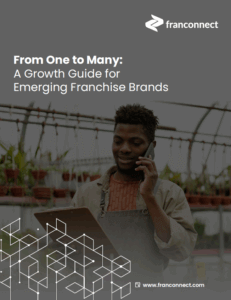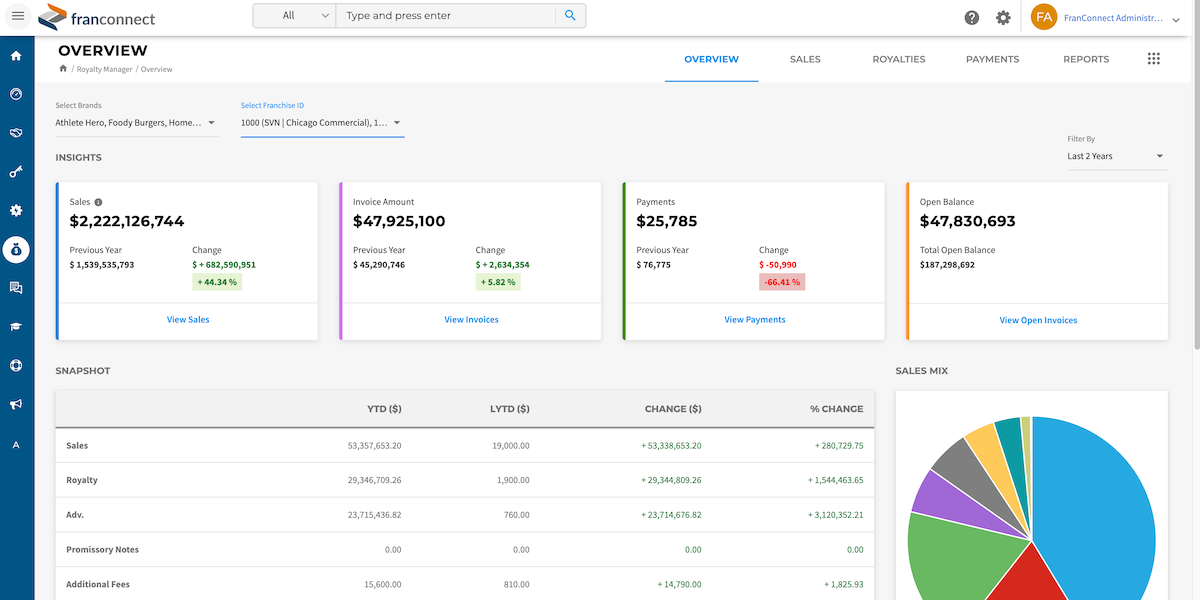Two hypothetical franchise brands at 50 locations face different realities. The “Patchwork Pizza” cobbles together a dozen different tools, while “Streamlined Subs” operates through a comprehensive franchise management system.
Eighteen months later, the results tell a stark story.
Patchwork Pizza’s CEO spends weekends reconciling data from five different systems, their newest franchisees wait three weeks for training materials, and two locations failed compliance audits.
Meanwhile, Streamlined Subs opened eight new locations ahead of schedule, achieved 98% compliance scores, and their operations team gained five hours weekly for strategic planning.
The difference? An enterprise-grade franchise management system designed for long-term growth versus fragmented, smaller solutions.
The Scaling Reality: When Small Solutions Hit Their Limits
Patchwork Pizza’s journey illustrates how quickly smaller solutions become growth barriers. What worked at 10 locations created chaos at 50.
The Fragmentation Trap
Patchwork Pizza’s franchise development team tracks leads in a basic CRM while using separate tools for training, compliance, and operations. When a qualified prospect calls asking about training requirements, the sales rep searches through three different systems to find answers. By the time they respond, the prospect has moved on to a competitor.
Critical data lives in silos. A prospect’s journey from initial inquiry to signed franchise agreement involves multiple handoffs between systems. Information gets lost, follow-ups fall through the cracks, and teams spend more time managing tools than building relationships.
Hidden Costs Compound Quickly
What seemed cost-effective for Patchwork Pizza at 25 locations became expensive at 50. They pay for multiple software licenses, manage various vendor relationships, and employ a part-time contractor just to reconcile data inconsistencies between systems.
Integration challenges multiply when different tools need to work together. Custom development, ongoing maintenance, and data synchronization create expenses that add up quickly without delivering additional value.
The 75-Location Breaking Point
As Patchwork Pizza approaches 75 locations, their limitations become critical barriers. Multi-state compliance requirements overwhelm their spreadsheet tracking system. Complex royalty structures strain their basic calculation tools. Their operations director spends entire days creating reports that should take minutes.
Without a robust franchise management system, franchise field operations become reactive instead of strategic. Teams firefight problems instead of preventing them, and growth stalls when momentum should accelerate.
Enterprise-Grade Capabilities That Matter for Growth
Streamlined Subs demonstrates how enterprise franchise management systems transform operations. Their comprehensive platform delivers capabilities that turn operational challenges into competitive advantages:
- Single source of truth allows their sales team to instantly access prospect information, training schedules, and performance data during calls.
- Real-time synchronization means when a new location opens, all systems automatically update without manual data entry.
- Multi-jurisdictional compliance tracking ensures every location meets local requirements without overwhelming the legal team.
- Automated audit trails provide documentation for regulatory reviews without additional administrative work.
- Configurable workflows adapt to unique business requirements without expensive custom development.
- Role-based access ensures franchisees see relevant information while protecting sensitive corporate data.
- AI-powered analysis identifies performance patterns that manual review would miss.
- Predictive insights flag potential issues before they impact operations.
These capabilities create measurable advantages. While Patchwork Pizza struggles with fragmented data and reactive processes, Streamlined Subs operates proactively with complete network visibility.
The FranConnect Advantage: 20+ Years of Enterprise Excellence
FranConnect is an excellent example of what growing brands need in a technology partner.
Proven Industry Leadership
FranConnect’s track record includes 1,500+ brands and 1.3 million locations served globally. The platform processes more franchise data than any other system, providing insights that benefit every customer. When 95% of FranConnect’s most active customers appear on Entrepreneur’s Franchise 500 list, the correlation between platform choice and franchise success becomes clear.
Enterprise-Scale Infrastructure
FranConnect’s 300+ employees globally across multiple continents provide round-the-clock support and continuous development. Unlike smaller vendors that might pivot or disappear, FranConnect’s 5X revenue growth over six years demonstrates the market confidence and financial stability that growing franchises need.
Purpose-Built for Franchising
Unlike generic business tools adapted for franchising, FranConnect was designed specifically for franchisor-franchisee relationships. Every workflow, report, and feature reflects deep understanding of franchise operations. The platform uses franchise-specific terminology and processes, from lead statuses to royalty calculations that handle complex multi-brand scenarios.
Strategic Innovation
Recent strategic acquisitions expand capabilities beyond what smaller solutions offer. The RizePoint acquisition enhanced quality management features. Investment in AI capabilities through Frannie AI provides predictive insights that transform reactive management into proactive optimization.
Long-Term Value vs. Short-Term Savings
The cost difference between Patchwork Pizza and Streamlined Subs extends far beyond software licensing:
- Integration costs for Patchwork Pizza include custom development, ongoing maintenance, and data synchronization expenses.
- Multiple vendor relationships require separate contracts, training, and support coordination.
- Administrative overhead includes the part-time contractor reconciling systems plus staff time managing multiple interfaces.
- Opportunity costs emerge when teams spend time on administrative tasks instead of growth activities.
- Unified platforms eliminate integration expenses while providing deeper functionality.
- Single vendor relationships simplify procurement, support, and training coordination.
- Comprehensive training on one system proves more efficient than managing multiple interfaces.
- Scalable architecture grows seamlessly from 50 to 500+ locations without platform migrations
Streamlined Subs invested in enterprise capabilities that scale with their growth. Patchwork Pizza pays more over time while receiving less functionality and facing constant integration challenges.
Conclusion: Making the Strategic Choice
The Patchwork Pizza versus Streamlined Subs comparison illustrates a fundamental choice facing growing franchise brands: accept the limitations of fragmented solutions or invest in enterprise capabilities that enable unlimited scaling.
Streamlined Subs’ success with FranConnect’s franchise management system demonstrates how the right platform transforms fragmentation into operational flow. With proven franchise expertise, enterprise infrastructure, and a track record supporting the industry’s most successful brands, comprehensive platforms provide the foundation for sustainable growth.
The most successful growing brands choose solutions that eliminate operational bottlenecks, ensure compliance confidence, and provide strategic visibility for informed decision-making.
Request a demo to see how enterprise franchise management systems can transform your operations from fragmented to streamlined.










 Ian Walsh
Ian Walsh








